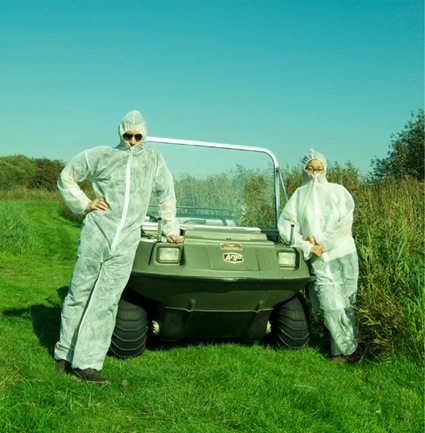 After Agri is a collaborative investigation between Michiko Nitta and Michael Burton. Their collaboration looks at the future evolutions of our food systems, asking What new cultural revolution will replace agriculture? How will our species and civilisation be transformed?
After Agri is a collaborative investigation between Michiko Nitta and Michael Burton. Their collaboration looks at the future evolutions of our food systems, asking What new cultural revolution will replace agriculture? How will our species and civilisation be transformed?
I met Michiko and Michael ages ago, when they were among the first students graduating from the course of Design Interactions at the Royal College of Art in London. I liked these two a lot at the time so when i found out in an exhibition guide that had teamed up to form After Agri, i thought i needed to have a close look at their website. It’s still early days for After Agri but their portfolio is as provocative and ingenious as i had expected.
Taking into account the latest advances in synthetic biology, geo-engineering, nutrigenomics and other areas of scientific research but also shifts in cultural taboos, issues of climate change and overpopulation, their latest projects include an exhibition exploring two possible future food cultures: Algaculture which proposed a greater symbiosis between algae and the human body and the Republic of Salivation, a dark scenario that sees Governments enforcing restricted food policies where the type of food a citizen receives responds to the emotional, intellectual and physical demands of their job.
More recently, Michiko and Michael were at the Victoria and Albert Museum with an ‘Algae Opera’ performance that demonstrated in the most spectacular how singers with powerful lung capacity might produce food in a future world where algae have become the world’s dominant food source.
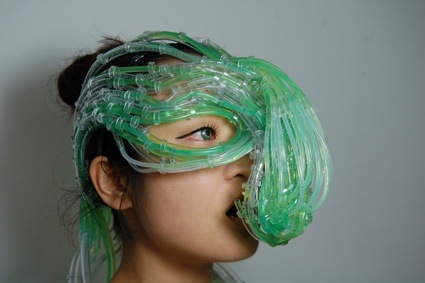 Algaculture
Algaculture
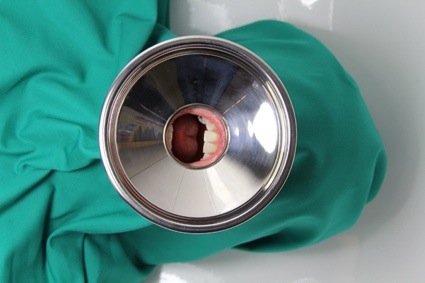 The Republic of Salivation
The Republic of Salivation
The Feast After Agri proposes new food cultures to revolutionize the way we feed ourselves. For the exhibition ‘Food Forward’ which took place at Stroom a few months ago, you explored two of the seven future food cultures from The Feast After Agri in greater depth: Algaculture and the Republic of Salivation. What are the other 5 future food culture? Could you describe them briefly and tell us which science and technology research has inspired them?
The Feast After Agri project searches for actions, research and experiments that might change the way we produce food and shape our world. Whilst some projects within After Agri propose new foods, we are fascinated by ways to redefine food altogether. We look for signposts to the changes in our behavior that might have a similar magnitude to our historic leap from a hunter-gatherer to an agriculture existence 10,000 years ago. And subsequently how new food and body-fuelling cultures will change our world and our human evolution.
Besides Algaculture and the Republic of Salivation, the Feast After Agri currently proposes five food cultures that respond to a variety of sources. For instance the Symbiotic Bacterial Nation creates a food culture shaped by synthetic biology.
The Subterranean Troglodytes carve out a new niche underground to seek refuge from the spreading desert and UV radiation baked surface of our planet.
Whereas Bovineopolis reflects what Carolyn Steel writes about in her book, Hungry City that “Cities have always moulded nature in their image”. Bovineopolis, takes a sideways look at the reality of in-vitro meat production. Here Fetal Bovine serum, an extract from a calf fetus, used in cell culturing is the city’s re-rendering of beef. These and the other proposals continue to be developed and will be worked-up to full projects in the future.
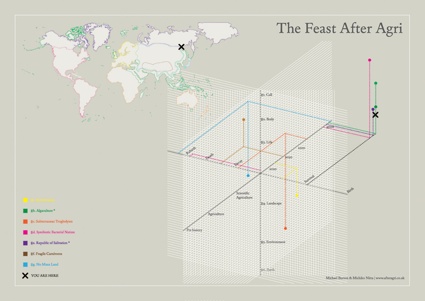 I also had a look at your map of the Feast After Agri and it seems that the various food cultures are distributed geographically? Which criteria makes you decide which food culture would be implemented in which part of the world?
I also had a look at your map of the Feast After Agri and it seems that the various food cultures are distributed geographically? Which criteria makes you decide which food culture would be implemented in which part of the world?
The map explores how new geographical boundaries and geo-engineering projects may be re-drawn on top of existing territories according to new food cultures. Instead of a standardized food culture across the globe, the Feast After Agri map charts the diversification in how we respond and evolve to our food and body-fuelling methods.
This map will change and be reconfigured as we add more food cultures and chart the changing climate and geographical composition over time.
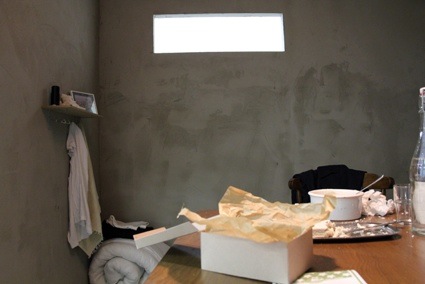 The Republic of Salivation: Dinner table, showing the process of eating Starch blocks provided by the government
The Republic of Salivation: Dinner table, showing the process of eating Starch blocks provided by the government
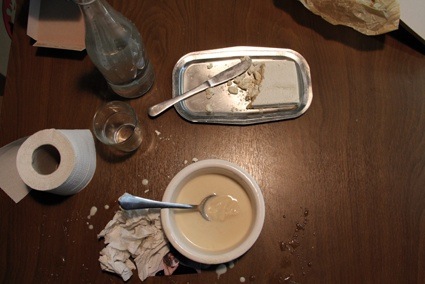 The Republic of Salivation: Dinner table, showing the process of eating Starch blocks provided by the government
The Republic of Salivation: Dinner table, showing the process of eating Starch blocks provided by the government
In your future food scenarios, do you also see differences in social classes with, for example, privileged people being able to carry on eating as we know it now?
The role between social class systems and diet is a very strong feature in most of the scenarios but particularly the Republic of Salivation. Here the design of diet is used by the Government to enable a citizen workforce to deliver their role in society. For instance, manual workers are given a provision of food that is high in modified starch – to enable the body to run for longer on the least food. Whereas the intellectuals of the country are fed scarcer food like fish, rich in omega 3 fatty acids and fresh fruit, to enrich brain function.
The scenario not only projects into the future but also reflects on the past. In developing the Republic of Salivation we were particularly interested in how food was re-evaluated as fuel for the work-force body in the Victorian workhouses.
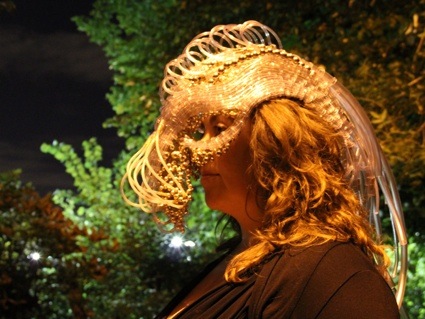
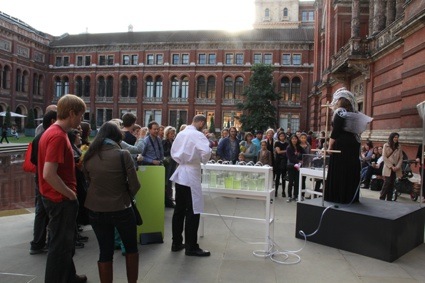 The Algae Opera, 2012. Part of the Digital Design Weekend at the Victoria & Albert Museum in London
The Algae Opera, 2012. Part of the Digital Design Weekend at the Victoria & Albert Museum in London
I’m curious about the The Algae Opera that took place last month at the V&A. Somehow, you managed to convince a mezzo-soprano to be ‘transformed with biotechnology to form a unique relationship with algae.’ What do you mean by “transformed”?
And can you describe the suit/mask she is wearing as well as the algae tank? How does it work exactly?
The role of transformation in The Algae Opera is a physical and cultural one. We identified the opera singer as the perfect body morphology for the production of algae. The singer’s large lung capacity was perfect to exhale the maximum CO2 to feed the algae. To facilitate the process further, the singer, Louise Ashcroft, worked with composer, Gameshow Outpatient, to re-design her singing technique.
The opera aspect of the piece was a second crucial component as we wanted to explore some exciting new research like that carried out by Charles Spence, Professor of Experimental Psychology at the University of Oxford called sonic food enhancement. Gameshow Outpatient and Louise re-designed many conventional operatic techniques. Gameshow Outpatient’s Matt Roger described the process as:
“We wanted to create a vocal ritual overtly focused on breath as much as singing, since breath is a fundamental connection between singer and algae, with breath control a technical fundament of singing itself. With this in mind we revisited traditional singing techniques to make explicit the role of breath and breath control in them, the impact on tone colour and stamina for example, seeking to explore ‘fragility’ as much as ‘strength’. We wanted the piece to represent an imaginary ‘folk’ music, born of a Human/Algae symbiote culture where breath itself is the revered symbol of existence.”
Louise’s role as a singer was also re-examined and she reflects on the process:
“I have to make a significant shift in the use of breath. The algae mask captures CO2 to grow the algae and requires a non-reflexive breath cycle to maximise CO2 output. This means the singer needs to take the breath cycle to the point of collapse. In today’s opera tradition, this type of breath cycle is considered inefficient and undesirable due to the issues surrounding sustainability and aesthetic. However, in The Algae Opera, a breath cycle based on a point of collapse is considered efficient and ultimately desirable, for it produces more algae.
In terms of the sonic enhancement of the algae, our relationship to pitch, tone and vocal colour also changes. Tone and colour in the algae framework is no longer linked just to text and texture, but also to flavour. What this means for me as a trained singer, is that I have to re-think technique, the purpose of the voice and explore a new vocal aesthetic to ensure that an algae sound creates food to feed you and me.”
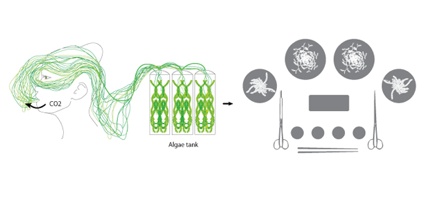
As shown in the diagram, the algae suit/mask works by pumping CO2 from the singer to the algae in the tanks. With a little fertilizer the algae feed and grow. Over a couple of performances the algae population is sufficient enough to harvest. In the opera piece, a chef strains the algae and uses it to make a sushi-like meal that is fed to the audience. The two acts of the opera are composed to consist of sound pitches to enhance the audience’s taste of bitterness and sweetness as they eat. As such, they consume the performer’s talent and taste her song.
Algaculture is fairly seducing but the Republic of Salivation is downright revolting (or maybe it’s just me). What reaction do you expect people to have when they discover the food cultures you’re bringing forward?
We’re not afraid to investigate the good, bad and ugly future of food cultures. We can’t escape the fact that we will have to change our food production methods. Already there’s a food crisis and our human population maintains its growth. And hungry people make for a future of panic, civil unrest, conflict and death. However, we still have the luxury now to think, explore, play and try alternative choices.
We are not only interested in the future food itself – we are fascinated in the largest systems that our food systems shape. The scientific research area of nutrigenomics reveals that we literally are what we eat. Our food guides our human evolution.
Also, we want to highlight the ecology of food systems. Therefore After Agri aims to discover how future food cultures will shape our physical world from town planning, landscapes and our global climate. We want to offer a glimpse into how developments in food technology will guide how we live together in societies, inform our political systems and give us new national identities. The projects also aim to consider how our future body-fuelling cultures will change our relationship with the planet’s biodiversity and may allow us to populate new ecological niches.
Although these are potential futures, we are not saying these will actually be the future. We hope they act as a mirror onto ourselves to consider the ecological web our food cultures impact on and the sacrifices we will be required to make in subsequent human generations.
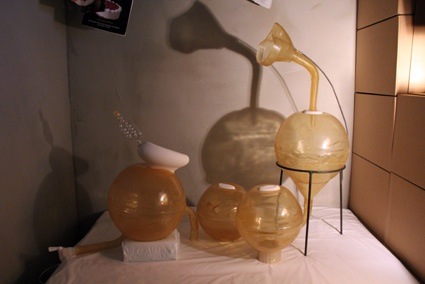 Are there any ongoing research in future way of feeding the population that you actually find exciting and would love to try out?
Are there any ongoing research in future way of feeding the population that you actually find exciting and would love to try out?
The full integration of algae into the body to make us semi-photosynthetic that features in the Algaculture project is something we would love to try. It’s the most extreme transformation of the body we’ve explored so far and it has the most sacrifices to our current way of life and dietary traditions. Despite these challenges, we would love to feel what it’s like to feed from the sun via the algae.
Also we are excited by the research of Alan Horsager, a neuroscientist at the Institute of Genetic Medicine at the University of Southern California. His research implants algae genes in the eyes of blind mice to regain a basic sight perception. In the development of the project we have briefly explored the potential of our bodies gaining a new bodily sensory perception through the light sensitivity of the algae when they are fully integrated, as an interesting by-product of a new dietary lifestyle.
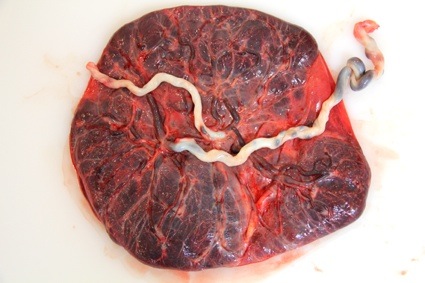 The human placenta. The image illustrates a story on foods from human origin in the journal “After…”
The human placenta. The image illustrates a story on foods from human origin in the journal “After…”
You just published After… The Birth Issue. Can you talk to us about the publication? What do we find inside? Is this the first one of a longer series of books related to a specific topic?
After… is a quarterly journal. Online it can be found at www.afterafter.co.uk. It features work that investigates, experiments and inspires new ways to see our world. It is a way to explore how all of us fit into our shifting and fascinating future.
The journal adopts free-thinking discovery to enhance our understanding of ourselves. We don’t want to wait for the future to happen to us. Instead, After… is a place for like-minded people who want to be a part of creating that future.
Inside can be found focused, reflective documentaries, proposals and prototypes for alternative futures. It’s a bit of a marriage of East meets West with influences from Michiko’s Japanese and Michael’s UK backgrounds.
Please let us know if you would like to receive our journal directly or be part of future editions.
Any upcoming project you’d like to share with us?
We are working on the autumn After… issue. We are currently working on two commissions that will launch in October and November. Also we are building ideas and work for a solo exhibition next year called Isoculture. Please check our website for further updates and launch news.
Thanks Michiko and Michael!
Previously: Extreme Green Guerrillas by Michiko Nitta and Future Farm by Michael Burton.
